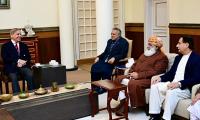Poverty reduction is the main objective of the global agenda for sustainable development. The identification of the poor and the evaluation of the extent of poverty has received considerable attention in the design of cost-effective poverty reduction programmes and safety nets.
The degree of poverty should be estimated to assess the budgetary needs / implications of safety nets and to evaluate these programmes. Therefore, the measurement of poverty has important policy implications. Poverty is one of the indicators used to determine the respective share of each province in the divisible pool of federal transfers to the provinces through the National Finance Commission (NFC) Award.
Several attempts have been made to construct poverty lines and generate poverty estimates in Pakistan. Recently, the government has adopted a cost of basic needs (CBN) approach to measure poverty, a uni-dimensional approach. According to the CBN approach, 24.3 percent of the population lives below the poverty line in Pakistan. Apart from this, Pakistan also uses the multidimensional poverty index (MPI) based on education, health and living standard dimensions. About 39 percent of Pakistanis live in multidimensional poverty.
The existing poverty estimates are subject to criticism due to lack of transparency, poor acceptance at the provincial level and the limited scope of measurement approaches. In addition, there are no reliable estimates of poverty available at the province level.
Poverty estimates need a new debate for accurate estimates and wider acceptance, especially from the provinces, the academia and the international community. This brief highlights some areas that require new insights and discussion on poverty estimates:
Poverty estimation methodology: Pakistan has shifted to the costs of basic needs (CBN) approach in 2013-14 which takes into account the non-food expenditures (for things like clothing, shelter and education) required for households along with food expenditures. The CBN approach is used to estimate poverty at national (24.3 percent) and regional levels [rural (30.7 percent) vs urban (12.5 percent)].
With regard to the estimate, several considerations must be taken into account: first, the poverty estimate should be updated periodically using the latest HIES data; second, the provincial estimates should be generated using the CBN methodology. To this end, the Pakistan Bureau of Statistics (PBS) should readjust the sample size to make it representative at the provincial level. A committee with provincial representation can be established to estimate poverty at the provincial level. Third, the rural urban definition needs more clarity to redefine rural and urban areas for a real estimate of regional poverty. It will help to make precise inflation adjustments.
Integrity and transparency of poverty estimates: academia and other stakeholders criticize poverty estimates due to lack of data transparency. Few measures can help to ensure the transparency and integrity of poverty estimates, including: i) the data file with the estimation code can be made public to allow other researchers to replicate the estimation to generate poverty numbers; and ii) the final consumption module on which poverty estimates are based can also be included in the microdata for comparison purpose. It will help promote poverty research and consistency in estimation. It is standard global practice to share the data with the estimation code to ensure transparency and gain the trust of researchers.
Greater acceptance of poverty estimates: poverty estimates are mainly produced by the Planning Commission (PC) without involving universities and experts. Both the academia and think tanks should be included in the discussion and estimation phase to induce acceptance at a broader level. It will also help update the estimation methodology and understand the underlying dynamics of the change in poverty.
Governance and institutional mechanism: it is proposed that a permanent unit or body be established with permanent staff (experts in poverty assessment) to periodically update poverty measures and estimation techniques. This forum should also be connected with the provincial representatives, the academia and think tanks for better understanding and consensus at the national level.
New approaches and possibilities to estimate poverty at sub-national level: as a signatory to the SDGs agenda, Pakistan should address all forms and dimensions of poverty. Poverty is a multifaceted phenomenon. Three types of poverty can be identified: income, social and environmental. There are huge disparities in poverty at districts level. The government should work to develop reliable estimates of poverty at the district level. To this end, the government can use the National Socio-Economic Registry (NSER) 2018-20 data collected by the BISP to calculate the census-based poverty. It will help to map poverty at the union council or tehsil level for targeted policy intervention.
Scope of MPI: the scope of the multidimensional poverty index (MPI) constructed by the PC with the help of the UNDP should include additional indicators and dimensions to extend the scope of the MPI measure. Any dimension such as health, education and living standard can be considered separately to include quality as we all quantity dimensions in the index for a better understanding.
Policy discourse analysis: The government should actively cooperate with the academia and with think tanks to explore the drivers of poverty reduction in Pakistan and define future policy discourse based on the nature and sustainability of observed decline in poverty. Inequalities can be explored because of its high relevance with redistributive policies.
Intergenerational poverty: the current understanding of poverty indicates large fluctuations in the incidence of poverty over time, since a greater proportion of the population lives around the poverty line subject to frequent movements in and out of poverty due to negative and positive shocks. Poverty reduction strategies often do not take into account these poverty transitions, due to data constraints. It is necessary to investigate the dynamics of poverty and the factors that underlie chronic, transient and intergenerational poverty.
The Pakistan Institute of Development Economics (PIDE) can help broaden the understanding of the dynamics of poverty using Pakistan Panel Household Survey (PPHS) conducted in 2001, 2004 and 2010, in which the same households are tracked over years and conducing fresh survey. The data from NSER 2010-11 would be useful to construct a large penal data with NSER 2018-20 to estimate chronic, transient and intergenerational poverty union council level for efficient delivery of safety nets programs.
This discussion provides a way to begin a new discussion on poverty estimates for the efficient use of public resources to alleviate poverty and improve the well-being of each citizen. The Division of Poverty Alleviation and Social Safety can provide a unique platform to implement the proposed suggestions to generate reliable poverty estimates.
The writer is associateprofessor at the PakistanInstitute of Development
Economics (PIDE).
Email: dr.iqbaln@gmail.com
Many people believe that in future, AI will play an even more significant role in their lives
In April 2024, three Chinese and one Belarusian company were sanctioned for exporting missile-enabling technology to...
Pakistan has second highest neonatal mortality in world; in education sector, country's 26 million kids are out of...
Key actors in global power politics are US, China, Russia, European Union, and emerging powers such as India and Brazil
Maulana Fazl manages to bring together factions that historically stand opposed
NASA says August 2024 set new monthly temperature record, capping Earth’s hottest summer since 1880







